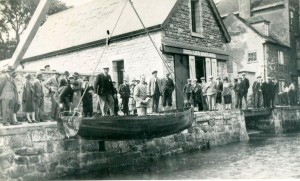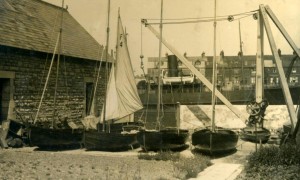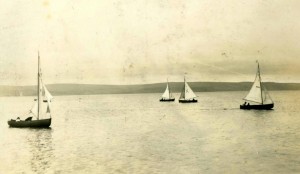The One-design Project
On September 2nd, 1926 the committee met to consider a motion tabled jointly by Capt. Hamblin and Mr. Pitcher ‘that the club should lay down two or more boats of a one-design class, for sale to members [and others] on any reasonable terms of payment. If built locally, the builder should be restricted to build no further boats on spec. for two years or until the first batch were disposed of.’ The Vice-Commodore [Mr. Pitcher] ‘spoke at some length on the suggestion,’ and after discussion he proposed and Hon. Treasurer [Capt. Hamblin] seconded that the principle contained in his suggestion be adopted and that the necessary financial backing be provided by the club. The motion was carried unanimously.
Mr. Bussell’s Blueprint
The sub-committee appointed to carry out this resolution consisted of the two protagonists and Mr. J. Taylor. Their first step was, naturally, to consult Mr. Bussell, who, in turn, lost no time in producing plans [if indeed they were not already up his sleeve]. Three weeks later [Sept. 24th] a set of blueprints for a projected one-design sailing dinghy was exhibited on the club room walls, and these received special mention at the annual dinner a month later [Oct. 23rd] by the Commodore who is reported to have said:-
‘The committee has long been of the opinion that a one-design class was essential, but until quite recently they had not felt that they were in a position to back the project in the way they would like. They were agreed that the time had now arrived when the question must be faced … and as a result Mr. Bussell had designed a boat which in their opinion fulfilled local requirements, viz. a fairly speedy boat 16ft. long and possessing a modem yet moderate sail plan of the familiar Bermuda type. It was fully realized that owners required a boat which, when not racing, possessed qualities of a robust enough nature to render her suitable for ordinary cruising needs.’
Adoption of Local Class
The club was now able to ‘back the project’ to the tune of £120 and it only remained for the committee to make sure that the design on view was popular enough to justify their embarking on production. This far-reaching decision did not remain long in doubt and, at a committee meeting on the evening of Armistice Day, 1926, Mr. Pitcher proposed ‘the formal adoption by the club of the one-design class and specification according to the boat now built by Mr. W. L. Bussell; and that the class be called the Weymouth Falcons,’seconded by Col. Saunders and carried.
Orders Come In

Launch of the first Falcon, ‘Sparrowhawk’, with the owner, Dr Llewellyn Pridham on board and Mr Bussell, the designer and builder supervising, 1927
Mr. Bussell had evidently chanced his arm by building the prototype model [‘Sparrowhawk’] as soon as the plans were out. and this act of faith was now justified by an order from the club, on Nov.25th, for four Falcons at a price of £40 each. The committee at first limited club expenditure on Falcons to £60, but as soon as orders started coming in they decided [Dec. 7th] to go the whole hog and raised the limit to the sky of the club’s resources, £135, at the same time asking Mr. Ridge to draw up a hire-purchase agreement. The next two orders came from Syndicates, the Commodore’s [Meek, Barnes and Mountain] and Vice-Commodore’s [Pitcher, Ridge, Gallop and Webb], both on hire-purchase terms. Two extra boats were accordingly ordered by the club, which undertook to pay £20 down on delivery of each, with the remaining £20 each in one year’s time; and on Jan. 7th 1927, Mr.Bussell undertook to produce five Falcons by the first week in May.
On this date also the committee approved a draft hire-purchase agreement drawn up by Mr. Ridge, who was co-opted onto the Falcon sub-committee.
The Committee’s Report
The next mention of Falcon progress occurs in the ‘Committee’s report’ on the balance sheet leaflet issued for the first time at the AG.M. on April 2nd. Here we read: ‘Falcon One-Design Class: In view of the continued prosperity of the club, the committee has at length decided to embark on a scheme which has been under discussion for several years. This decision has been amply justified by the enthusiastic manner in which it has been received. No fewer than six boats have been ordered, the names and owners being as follows:-
| No 1 | Sparrowhawk | Dr. H . Ll. Pridham. |
| No 2 | Osprey | Mr. W. L. Bussell. |
| No 3 | Merlin | Mr. F. W. Bratby |
| No 4 | Kestrel | Commodore’s syndicate |
| No 5 | Kite | Mr. Gallop’s syndicate |
| No 6 | Buzzard | Lt.Cmdr. Burton, R.N. |
This leaflet also supplies some interesting information about the club’s winter activities, notably [1] that nine lectures were held, including ‘Criminology’ by Mr. Ridge, ‘The Truth About China’ by Dr. Ll. Pridham, and ‘Early Aviation on the Coast of Palestine’ by Capt. Chris. Smith and [2] that Capt. Hamblin started the idea of club suppers by inviting members to sup with him one evening in the club-room. ‘This innovation proved so popular that it was followed by two further suppers, the committee being hosts on the first occasion, and the members returning the compliment on the second.’
The balance sheet showed £138 in hand, and in this connection the meeting approved a new rule, 5A, vesting the affairs of the club in two trustees, Mr. Hownam Meek and Capt. Hamblin ‘with powers to invest money and adopt such measures as shall appear to them necessary in the interests of the club, subject to the approval of the committee.’
The officers of the club were all re-elected. the only change being that Mr. Pitcher, declining to stand again as flag officer, was elected Treasurer, thus exchanging offices with Capt. Hamblin who became Vice-Commodore. Mr. Hownam Meek agreed with Mr. Pitcher that an infusion of new blood was a good thing and offered to stand down, but he was nevertheless re-elected for the seventh, and final time.
A scheme to enable boat owners to insure against damage or loss was put forward and accepted in principle, but a committee of investigation subsequently turned it down ‘on account of the large risk to which the club would be exposed financially’ and the idea was accordingly dropped. An alternative scheme to cover winter storage was recommended as being sufficient to satisfy members’ demands.
Plans for 1927
Referring to the coming season, the aforesaid committee’s report observes: ‘with the advent of the One-design class, the 1927 season promises to be one of considerable interest as, in addition to ordinary club races [Weds. and Sat. afternoons] it is proposed to organize a series of evening matches [for Falcons] when ‘in order to provide variety it is proposed to establish a fixed mark in Redcliff Bay and a second in Bowleaze Cove, giving a run out and a beat back, alternative to the usual triangular courses.’
Among new members elected this year were Lieut.Cmdr. Burton,
W. [Bill] Fisher, Cmdr. F. P. Saunders and a white haired Irishman named Michael Gallagher. Dr. Llewellyn Pridham at this time had the good fortune to acquire not only a Falcon but also a wife, and Mrs. Kitty Pridham became the club’s fourth lady member. The cadets were also augmented by Freda Bratby and Doreen Breach.
For starting purposes it had been the custom for some years to designate the classes A, B and C by the flags X, Y and Z respectively.
With the arrival of the new class it was now decided to incorporate C class with B, using the X flag, thus freed, to designate Falcons.
Falcon racing was regulated by a new Racing Rule 8, the stipulations of which included: no ballast, no spinnakers, crew not less than two or more than three, buoyancy tanks of 12 gallons minimum, anchor 12lbs. with 15ft. of approved rope.
The idea of distinguishing marks on Falcon sails seems to have been initiated by Mr. Gallop who embellished ‘Kite’s’ sail with a square. In 1928 Dr. Pridham followed suit by giving ‘Sparrowhawk’ the medical trade mark of a red cross, and other devices followed [‘Hobby’ – circle, ‘Osprey’ – triangle, ‘Merlin’ – X], to produce a feature unique to the Falcon class. Falcons were supplied complete with one suit of sails but anchor cable, topping lift and claw were 50s. extra making the inclusive price £42. 10s. This low cost was made possible by the elimination of decking and all superfluous frills, one of the objects of the design being to produce a boat within the reach of all pockets. The Falcon was, and still is [1955], the cheapest 0-D boat on the market.
Racing
The first five Falcons [‘Sparrowhawk’, ‘Merlin’, ‘Kestrel’, ‘Kite’ and ‘Buzzard’] were launched before an admiring crowd in May; and these boats, together with ‘Cuckoo’, made their first official appearance in the Bussell Cup match v. Lyme Regis on June 20th, when the home team [Hamblin, Burton and Pitcher] successfully defended the trophy by 25 points to 15. Bussell Cup matches were also held against West Bay and Parkstone with equal success, although a match against the officers of
H.M.S. ‘Revenge’ was lost by two points and friendly matches at Bridport and Lyme Regis were lost by six and sixteen points respectively.
The first challenge cup for Falcons was put up by Col. Saunders and was won by Lt. Cmdr. Burton in ‘Buzzard’ in the first official Falcon race, on Aug. 12th, 1927. A second Falcon cup put up by Mr. Hownam Meek was competed for in a series of Thursday evening races beginning on June 9th, and this was finally won by Mr. Gallop in ‘Kite’.
The Ladies’ Race, for which the Dorset Daily Echo now presented a perpetual challenge cup, was sailed in Falcons, in two heats of five, on Aug. 13th and was won in the final by Mrs. Saunderson in ‘Buzzard’. Mr. G. Stevens, editor of the Echo was elected an honorary member as a mark of appreciation of his interest in the Club.
The Cadets’ race was also sailed in Falcons, in three heats of three, on Sept. 3rd, and was won by Miss Breach.
Meanwhile competition in the A and B classes was so keen that ties occurred in no less than three cases – the Baldwin, Club and Franklin Smith Cup series. These ties were sailed off between the three pairs of skippers concerned in two Falcons – ‘Buzzard’ and ‘Kite’ – on Sept. 30th and were won in each case by the skipper who drew ‘Kite’, in three very exciting races which resulted as follows:-
Baldwin Cup: T. W. Graham beat T. R. Wakefield by seven seconds;
Franklin Smith Cup: A. H . Warren trounced Capt. Hamblin by five minutes;
Club Cup: S. G. Gallop beat Lt.Cmdr. Burton by 13 seconds; – there were evidently no weeds on ‘Kite’!
As a footnote to the season’s activities it is interesting to note that the headgear favoured by members for sailing was a stocking cap knitted in club colours – a fashion which lasted until the early thirties.
The Falcons Take their Bow
Commenting on the season’s activities in his speech after the annual dinner at the Gloucester Hotel, Mr. Hownam Meek said ‘the new Falcons had taken most of the limelight. They had proved a wonderful success; their speed and seaworthiness were remarkable and the Thursday evening races had been the most popular series of the season.’
The Mayor, Councillor P. J. A’Court, who presented the prizes, said that ‘he could not recollect any function in which he gave away so many prizes in one night’ – there were 15 cups, 9 replica cups and 31 spoons. He might have added ‘or listened to so many speeches’ since five toasts and seven responses, a total of twelve, are listed on the programme!
In proposing the vote of thanks to the Mayor, Capt. Hamblin pointed out the great advantages of Weymouth Bay for small boat sailing, saying that ‘races held in other places put a handicap on strangers owing to their lack of knowledge of tidal currents, etc.’ Mr. Mowlam, of Parkstone, referred to his early association with Franklin Smith ‘who was practically the founder of the Weymouth Sailing Club’ and added his tribute to the Falcons by saying ‘the club had taken the right step in instituting a one-design class.’
Thus the Falcons took their bow, the success of the new venture was sealed and another long-standing ambition had been fulfilled.

